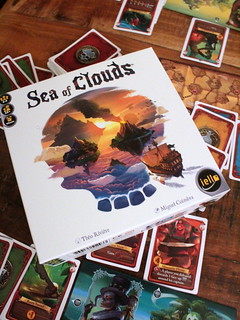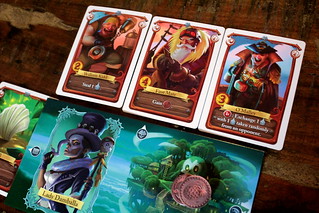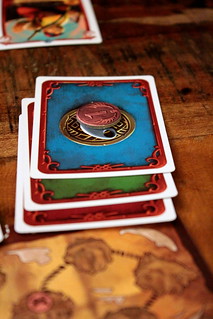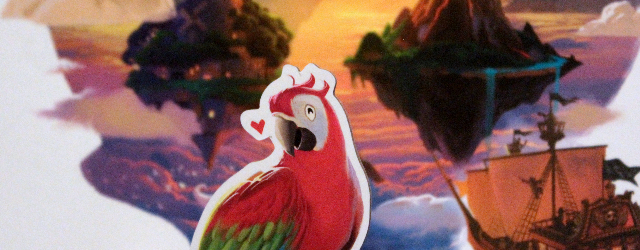| Strategy | Luck |
|---|---|
| Interaction | Components & Design |
| Complexity | Score |
A Pirate’s Life – The Rules
Sea of Clouds combines elements of drafting games with a press-your-luck mechanic. All air pirate captains want to have the most valuable collection of loot at the end of the game. To get there, each of them picks one pile of loot per round. There are three of those piles, all cards on the loot piles are always face down, and each starts with only one card. On your turn, you look under the first pile and decide if you want to take it or not. If you want a loot pile you take everything on it, replace it with one new card and end your turn.
If you don’t like the first pile, you can put it back and look at the second. The moment you pick up the second pile, the first one is off-limits, you can’t go back to it no matter how bad the second is. If you doesn’t like the second one either, there’s still the third, but again there’s no going back. And if the third loot pile stinks as well, you can refuse that and draw a single card from the draw pile. That’s the press-your-luck part. You always have to wonder if maybe the next pile of card is better, but if you want so see it you have to commit to it. You’re not completely without information about the other piles. The card back shows what types of cards there are, but you can’t be sure how good they’ll turn out to be.

The drafting part is that all cards you left behind are up for grabs for the next player. Worse than that, every pile that you look at but put back gets another card or a coin added to it. So every time a loot pile isn’t good enough for you, you make it better for your opponents. How good a loot pile is for the other players is an important question, anyway. Depending on the loot you already collected a card may be a valuable addition for you, or it may be useless. And just like other drafting games, you’ll sometimes take cards that don’t help you because they’d be too valuable for an opponent.
Just how valuable a card is depends on its type. Relics are the easiest to figure out: the more you have of one kind of Relic, the more valuable each is. Having only one actually costs you points in most cases. Collect a lot of Siren Song, though, and that’s probably enough to decide the game. Relics are also easy to figure out because relic cards are kept face up. When you have a big collection of Behemoth Teeth you want to show it off.
Rum cards are harder already. All pirates want to collect Rum, of course, that’s what being a pirate is all about. But they keep details about their collection secret and the cards face down. Some Rum cards are simply worth points, or give you negative points in the case of especially bad moonshine. But there is also Collector’s Rum that scores like a Relic, and there is Top-Shelf Rum that is worth more points to the player who collected the most.
Objects are complex in a different way. Most Object cards have a permanent effect described in the card text. Some, like the Sextant, are strictly positive. The Sextant protects you from negative points from relic cards. Other Objects are harder to find a good side in. When you have a Cursed Idol you have to discard a card from your tableau or pay a coin at the start of every turn. Mostly not what you want, but it is a great way to get rid of even worse cards. And then there are Objects with a secret ability that will give you points at the end of the game based on a condition described in the text. Unlike other Objects you keep them hidden from the other players.

And then, finally, you have the Pirates. You obviously need a crew, right? Pirate cards are important when, every few rounds, the pirate ships converge and send boarding parties to steal each others’ hard earned loot. Yeah, I lied about the peaceful discussion over tea. Pirates have two characteristics, their strength and their ability. At the end of a boarding round you compare the combined strength of your Pirates with both your neighbors, similar to war in 7 Wonders. For each fight that you win, your Pirates get to use their abilities. Some let you take money from the supply, others steal directly from your victims. Rum, money, objects – only relics are safe. Some especially sneaky Pirates exchange things with a defeated opponent. If stealing from them is bad already, imagine how delighted they will be when you leave a Cursed Idol hidden on their ships…
After a number of rounds that depends on the number of players, the game ends and you count points. You can have an idea how good you’re doing, but revealing everyone’s hidden cards is always good for a surprise. Especially scores based on majorities – Top-Shelf Rum and some of the secret Objects – often shake things up a bit. But there are no reasons to be really surprised once you know what cards there are, meaning from the second game forward. If you pay attention to an opponent’s collection and what they seem to focus on, you can guess their secrets. And if you can guess their secrets, you can take the cards they need and beat them. All is fair in a pirate contest, after all.

Is it the life for me? – Our Verdict
The first thing you’ll notice about Sea of Clouds is how quick it is, both to learn and to play. Well, no, I lie. The first thing you’ll notice is how pretty it is. Iello continue to deliver great production values even for a simple card game – I adore the multi-layered print on the box – and Miguel Coimbra did yet another fantastic job on the illustrations. Then you’ll notice how quick it is. You can have new players ready to play in five minutes or less. And even with newbies, the 45 minutes playing time are realistic. And they are 45 busy minutes, the short turns make sure that there is very little downtime.
But the more important point is: are they 45 fun minutes? And that is another strong yes. Sea of Clouds combines the good parts of the two main mechanics. The tough decision whether you should take what you have or try for something better of a press-your luck game. The interaction with your opponents by withholding cards they need from a drafting game. It’s not quite as strategic a drafting game as 7 Wonders, for instance, because of that added bit of chance. And that’s fine. Sea of Clouds doesn’t try to occupy the same niche, it’s its own, unique combination of mechanics. It’s light, it’s quick, it’s exactly the right level of interactive for a game of this weight. And while luck does play a role, the cards hold enough ways to score that you can deal with most situations by playing smart. Sea of Clouds is a great combination of mechanics, and it works as a fun game for gamers just as well as it does as a family game.










